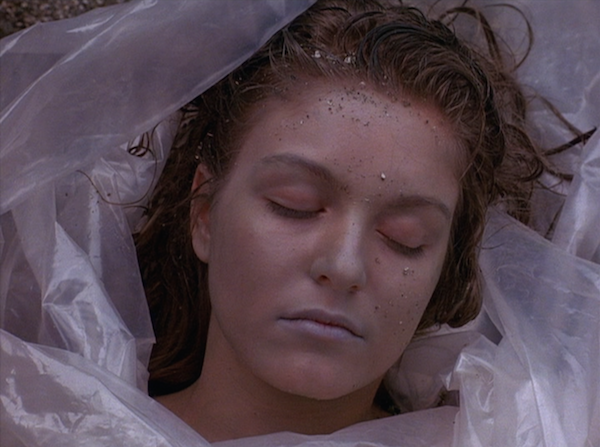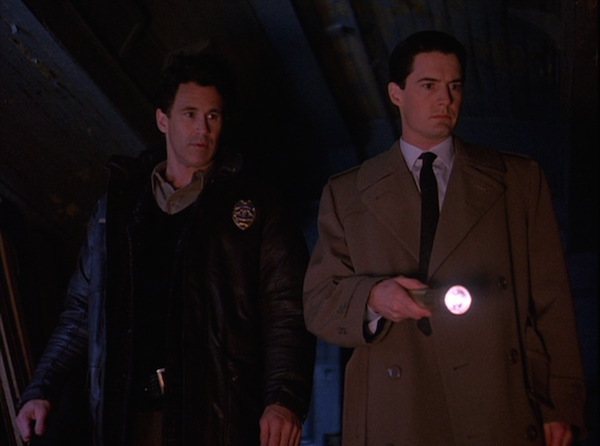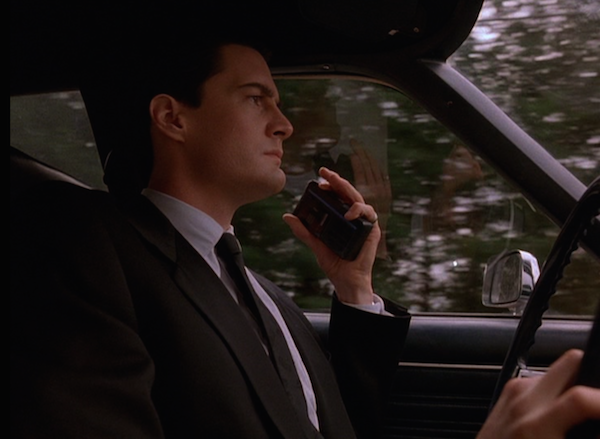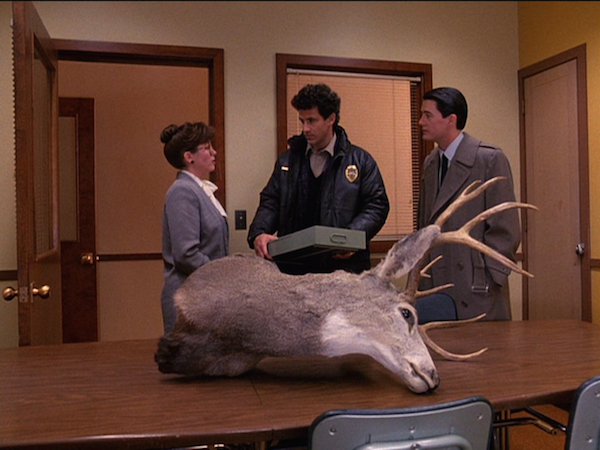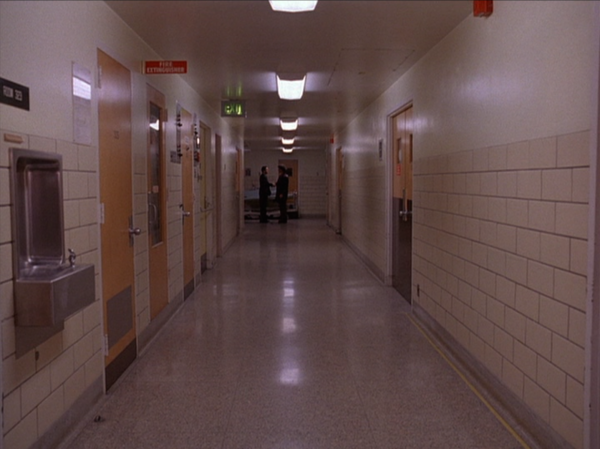Twin Peaks, Season 1, Episode 1, “Northwest Passage”
Written by Mark Frost and David Lynch
Directed by David Lynch
Aired April 8, 1990 on ABC
“Diane, 7:30 am, February 24th. Entering town of Twin Peaks. Five miles south of the Canadian border, twelve miles west of the state line. Never seen so many trees in my life. As W.C. Fields would say, I’d rather be here than Philadelphia. … Lunch was $6.31 at the Lamplighter Inn. That’s on Highway Two near Lewis Fork. That was a tuna fish sandwich on whole wheat, a slice of cherry pie and a cup of coffee. Damn good food. Diane, if you ever get up this way, that cherry pie is worth a stop.” – Dale Cooper
In the nearly 25 years since Twin Peaks debuted on ABC, the show has achieved an almost mythic status in the canon of television. Not only has it influenced a legion of other shows, but its various elements and images have become indelible parts of pop culture. Appreciation of cherry pie and damn good coffee. A lady with a log that she treats like a beloved friend. A dwarf dancing in a room with red curtains and a zig-zag carpet. When people think of Twin Peaks, they think of its oddities, and with good reason: the surreality is so distinct that it lingers, long after the details surrounding it have faded.
But to consider Twin Peaks for only its quirks is to diminish everything else it did so well. Yes, the show did more to bring experimental film techniques to broadcast TV than any other show before it, but what’s lost in that shuffle is how well-constructed it is, both tonally and narratively. David Lynch and Mark Frost didn’t set out to create a freak show, they had a very particular image of small-town America that they wanted to bring to life. And in terms of building a world, it’s hard to do it better than Lynch and Frost did in the first episode. ABC gave them the space to do a feature-length pilot, and they take advantage of the full 90 minutes to lay out the entire town in marvelous detail, giving just enough time to every lie and oddity that one can’t help but be drawn in.
The pilot lulls viewers into the tone of the show instantly with the opening credits, which play out for a full two and a half minutes over a series of unassuming images: a city limits sign, a sawmill at work, a robin greeting the morning, a waterfall tumbling down into a river. These images are underlaid with the synthesizer-heavy Angelo Badalamenti theme song, an instrumental version of “Falling” by Julee Cruise (a longtime Lynch and Badalamenti collaborator, who appears later this episode in the glorious incongruity of singing sweetly to a biker bar). It tells you nothing about what you’re about to see, but the overall effect is eerie in its simplicity, images that seem borne of snippets remembered from a dream from which you’ve just awoken.
It’s a dream that becomes a nightmare with the discovery of the body of Laura Palmer (Sheryl Lee). Homecoming queen, daughter of respected attorney Leland Palmer (Ray Wise), golden girl of the town, now reduced to five words beautifully stuttered by logger Pete Martell (Jack Nance): “She’s dead. Wrapped in plastic.” Laura’s corpse is beautifully shot by Lynch, eliciting a sense of loss with its stillness and bluish tint in a way that trumps any other crime procedural stiff-of-the-week. And as the news spreads across the town, the pacing of the reveals goes hand in hand with the Badalamenti beats, the crescendo of Laura’s theme building parallel to the emotional climaxes: The moment the plastic is pulled off Laura’s face. The sheriff going to tell Leland about his daughter’s death as he’s on the phone reassuring his wife. The high school principal breaking down at the end of his announcement to the school. Heightened emotions are a hallmark of Lynch’s work, and his deployment of them here makes Laura’s death as important to the viewer as it is to the people that loved her.
While the emotional toll is the pilot’s immediate focus, Lynch and Frost make it clear that what’s happened to Laura is more important as a catalyst than a tragedy. The day-to-day life of Twin Peaks continues on without her, and her absence exposes the underlying issues that the world possesses. Sawmill owner Josie Packard (Joan Chen) opts to shut down in recognition of the horror, a move that exposes friction with her sister-in-law Catherine (Piper Laurie), which then leads to the reveal of a conspiracy between Catherine and local businessman Benjamin Horne (Richard Beymer). Horne’s daughter Audrey (Sherilyn Fenn) uses news of the murder to stir up trouble, and ruin her father’s business deal with a contingent of Norwegians. Laura was cheating on her boyfriend Bobby (Dana Ashbrook) with classmate James Hurley (James Marshall), and now that she’s gone, James finds himself growing closer to her best friend Donna (Lara Flynn Boyle), while at the same time Bobby continues his affair with waitress Shelly (Madchen Amick). Everything is connected, and any one character’s actions can resonate with at least four or five other people.
All of those details make Twin Peaks a convoluted undertaking starting out, but what keeps the viewer fascinated is the show’s degree of disconnect. Everyone involved—with the exception of authority figure Sheriff Harry S. Truman (Michael Ontkean)—falls on a spectrum of odd behaviors, ranging from the light ditziness of receptionist Lucy (Kimmy Robertson) to the full-bore eccentricity of psychiatrist Dr. Jacoby (Russ Tamblyn). Serious bits of the murder investigation are juxtaposed with random flights of fancy, such as a high school student randomly popping down the hallway or a woman with an eyepatch yelling about drapes from her front porch. The length of the pilot is a definite advantage here, as all of these moments get plenty of time to breathe—and in a testament to Lynch’s restraint, he pulls back from these moments before they become self-indulgent. Twin Peaks isn’t about one central weirdness, it’s the sum of individual oddities, and all of those oddities are fully realized starting out.
Into this world comes one Special Agent Dale Cooper, played by Blue Velvet and Dune star Kyle MacLachlan. Normally on a show with this much established weirdness in its setting, you would expect a character like Cooper to fill the fish-out-of-water role seen in such narratives as Doc Hollywood and Northern Exposure. However, Cooper subverts expectations from the first moment of his introduction, focusing on the minutiae of his schedule and dictating every activity to an unseen “Diane” via tape recorder. He pivots between positions seamlessly, telling Truman one minute that he’s the boss going forward on this investigation and then asking a split second later with a boyish grin: “What kind of fantastic trees have you got growing around here?”
It’s an interesting take on the point of entry character, and it works because MacLachlan nails every beat of this individual. And there are endless beats worthy of notice, even this early on: The matter-of-fact way he cracks open the hinge of Laura’s diary when the key is missing, his unfazed demeanor in the face of Bobby’s histrionics, the unironic way he whittles a flute while on stakeout. There’s a competence and comfort to Cooper’s bearing, an earnestness that makes you believe he can be simultaneously fascinated with the town and a highly qualified investigator.
Those investigative skills are going to be necessary, as the tone of murder mystery quickly takes on the darkest of dimensions. Laura’s good girl facade is stripped away by evidence of a cocaine habit and $10,000 in a safety deposit box. A catatonic victim walking across a bridge, full of scars and ligature marks, makes it clear just how brutal the conditions of this murder were. And the discovery of the train car charnel house takes the crime from merely violent to outright ritualistic, with four cryptic words found at the scene: “FIRE WALK WITH ME.” Much as Blue Velvet pulled back the facade of suburbia, Twin Peaks attacks the placid demeanor of the small town, asking the questions of just what we know about our neighbors, and what ugly undercurrents flow through the diners and high schools.
It’s small wonder this was an instant sensation when it first aired, as it’s lost none of its power or craftsmanship 25 years later. Beyond the central question of “Who killed Laura Palmer?” and all attendant queries (Where’s the other half of the necklace? Who’s the “J” mentioned in Laura’s diary? What’s the significance of the letter under the fingernail?) you have a real estate conspiracy, no fewer than five affairs, the possibility of a serial killer, and enough haunting visuals to power a week’s worth of nightmares. Simultaneously luring you in, demanding you pay attention, challenging your comfort zone, and daring you to look away, it’s hard to find another show that leaves so potent an impression in its first outing as Twin Peaks.
Pie crusts and coffee grounds:
- Welcome to Sound On Sight’s coverage of Twin Peaks! As announced last week, we’ll be going through the entire series, doing one episode a week.
- Re: the episode titles. Lynch and Frost only designated episodes by number, but titles were later assigned when the series aired in Germany, and are still used on the CBS website. For ease of discussion, we’ll be using those titles.
- The DVD releases of the show contain introductions from the Log Lady, written by Lynch, and originally created when the show was re-aired on Bravo. This week’s intro: “Welcome to Twin Peaks. My name is Margaret Lanterman. I live in Twin Peaks. I am known as the Log Lady. There is a story behind that. There are many stories in Twin Peaks—some of them are sad, some funny. Some of them are stories of madness, of violence. Some are ordinary. Yet they all have about them a sense of mystery—the mystery of life. Sometimes, the mystery of death. The mystery of the woods. The woods surrounding Twin Peaks. To introduce this story, let me just say it encompasses the All—it is beyond the Fire, though few would know that meaning. It is a story of many, but begins with one—and I knew her. The one leading to the many is Laura Palmer. Laura is the one.”
- While it succeeds as a whole, Lynch’s direction has so many individual moments worth noting. Josie putting on her makeup in the morning, her mind miles away, framed in a way that accentuates how out-of-place this elegant persona is amidst the bickering Martells:
- Cooper and Truman’s first meeting, which takes place at the very end of the hospital hallway, so they have to come to the audience rather than the other way around:
- The “policeman’s dream” donut setup in the Twin Peaks Sheriff’s Department, a bastion of order in the chaos:
- The variety of the Twin Peaks cast is as interesting as the show’s narrative. Beyond the Lynch players like MacLachlan and Nance and the pool of young actors to play Laura and her friends, the cast is stocked with faces recognizable across a variety of projects. Beymer and Tamblyn were veterans of the 1961 West Side Story film, Peggy Lipton was the female lead of The Mod Squad back in the late 1970s, Laurie had multiple Emmy and Academy Award nominations to her name, and Chen had broken out a few years earlier with The Last Emperor. All of these people had done good work, but they’d never done work quite like this, and they quickly became as irreplaceable as the creators.
- One of the oddest moments in the episode came as a happy accident, an example of the improvisational spirit that drives parts of the show. During the shooting of the scene where Cooper examines Laura for the first time, the crew couldn’t get the lights to stop flickering, but Lynch liked the effect so much he kept it. Similarly, the orderly’s response to Cooper’s request to be left alone of “Jim” is because the actor misheard the line, but (again) the result was one that Lynch felt set the right tone.
- The pilot takes its emotions seriously, though Truman’s frustration at Deputy Andy’s sobbing is an instance where it’s possible to find some unintentional laughter: “Is this gonna happen every damn time?” Though admittedly, it does speak well of Truman that he’d employ a deputy so quick to tears.
- Ben Horne’s sales pitch to the Norwegians, quoting one of their enthusiastic troupe: “My air sacs have never felt so full!”
- “Diane, I’m holding in my hand a small box of chocolate bunnies.”
- “Who’s the lady with the log?” “We call her the Log Lady.”
- “I will remind you, these crimes occurred at night.”
- “I suppose you want me to follow at a discreet pace.” “Harry, you’re all right.”
- “Well… tomorrow comes early.”
Next week: The investigation begins in earnest with “Traces To Nowhere,” as Cooper and Truman dig into Laura’s friends and family, and the coffee is black as midnight on a moonless night. Just beware of the fish in the percolator.


